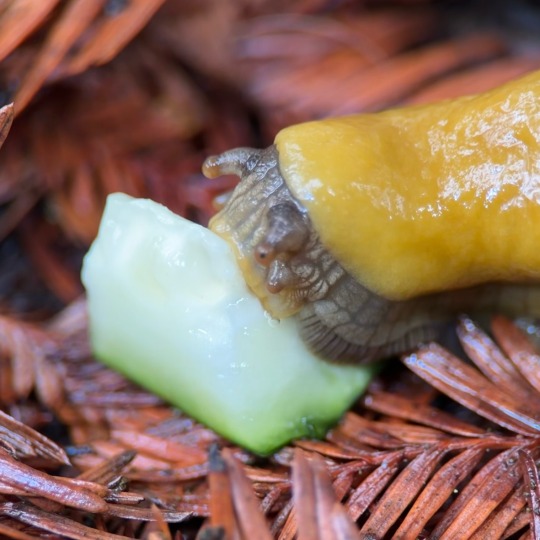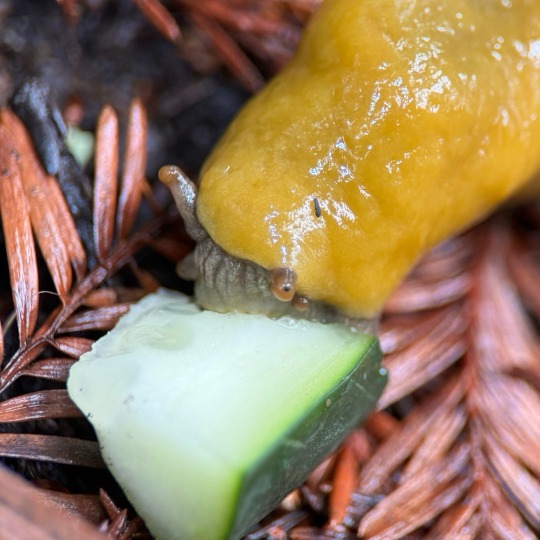Amateur photographer, naturalist, and artist based in North Carolina and occasionally California and Pennsylvania. All photos are posted to iNaturalist. This blog is to promote invertebrate appreciation. Insect, spider, etc. hate is not welcome. They're just tiny animals trying to get by, and they all play an important role in the ecosystem. And if you’re thinking of stealing my work for AI, you can kindly fuck off.personal blog: https://tumblr.com/lady-silver-ice cosplay page: https://tumblr.com/silvericedragon
Don't wanna be here? Send us removal request.
Text






Assorted cute bumbles <3
Yellow-faced bumblebee (Bombus vosnesenskii): upper row and bottom right California bumblebee (Bombus californicus): center row and bottom left
Northern California, US
60 notes
·
View notes
Text






Assorted cute bumbles <3
Yellow-faced bumblebee (Bombus vosnesenskii): upper row and bottom right California bumblebee (Bombus californicus): center row and bottom left
Northern California, US
#native wildflowers planted by me :-)#california poppy#lupine#clarkia#bumble#bumblebee#nature#bugs#nature photography#bugblr#biodiversity#animals#inaturalist#arthropods#entomology#insect appreciation#bee bumbles#cute bee#cute bugs#cute#garden#hymenoptera#bombus#bees#pollinator garden#native plants#macro photography#flowers#wildflowers#iphone photography
60 notes
·
View notes
Text



Unknown species of water boatman (family Corixidae), northern California, US
These bugs (actual bugs, i.e. Hemiptera) use their legs as oars to swim around. Most, but not all, species live in freshwater. This family contains pretty much every common eating habit - herbivores, carnivores, detrivores, and omnivores.
I found this one in the pool btw.
#pool time friends#water bug#boatman#corixidae#bay area#california#bugs#nature#bugblr#animals#inaturalist#biodiversity#arthropods#entomology#insect appreciation#hemiptera#bug#nature photography#aquatic creatures#aquatic life#water boatman#creature#row row row your boat#freshwater
68 notes
·
View notes
Text
Meat-Eating Caterpillars: less than 1% of all known lepidoptera (moths and butterflies) are carnivorous, and even fewer are known to hunt and kill their prey; these are just a few of the exceptions

Above: a carnivorous pug moth caterpillar, Eupithecia orichloris, ambushing a fly
Lepidopteran predators are extremely rare, but they do exist. Some of the most interesting examples include the carnivorous pug moth caterpillars of the genus Eupithecia, the ant-eating casebearer, the Hawaiian snail-eating moth, and the bone-collector caterpillars of the genus Hyposmocoma. Curiously, almost all of the species on this list are endemic to Hawaii.

Above: Eupithecia orichloris
The carnivorous pug moth, Eupithecia orichloris, is probably the most famous predatory caterpillar in the world, thanks to the striking and unusual method by which it captures its prey -- this species is an ambush predator that often disguises itself as a twig and then pops up out of nowhere, violently plucking its prey from the foliage. Eupithecia is the only lepidopteran genus that is known to contain ambush predators, which makes this behavior seem even more striking.
The ant-eating casebearer, Ippa conspersa, is another carnivorous caterpillar that feeds on ants and other insects (both as a predator and as a scavenger). This species uses silk, sand, and other fine debris to build a flat, peanut-shaped "shell" around its body, and the "shell" acts as a kind of camouflage, allowing the caterpillar to sneak into ant nests and hunt.

Above: the ant-eating casebearer and its unique "shell"
As its name implies, the ant-eating casebearer often feeds on ants, but it has also been known to eat cockroaches and other insects.

Above: an ant-eating casebearer feeding on a cockroach
Hyposmocoma molluscivora, commonly known as the Hawaiian snail-eating moth, is a casebearing caterpillar that feeds on live snails. It uses strands of silk to immobilize its prey, tethering the snail in place so that it can climb into the victim's shell and feed on the soft flesh within. The caterpillars of this genus are the only lepidopterans that are known to feed on molluscs; all of the other predatory caterpillars feed on arthropods (insects and arachnids).

Above: this photo shows a Hawaiian snail-eating moth using strands of silk to hold its prey in place
The genus Hyposmocoma also contains the predatory "bone-collector" caterpillars, which cover themselves with the body parts of other insects and arachnids, often scavenging the leftover pieces from spiderwebs. They carefully trim each piece of exoskeleton and then arrange them all together onto a portable silk mesh.
The caterpillars often live side-by-side with spiders, as they opportunistically feed on the insects that they find trapped in spiderwebs, and their macabre body ornaments likely serve as camouflage; they allow the caterpillar to avoid being detected or attacked by spiders.

Above: a bone-collector caterpillar covered in the body parts of other insects, including a large weevil head that is clearly visible near the center, several ant heads, a fly's leg, the abdomen of a bark beetle, a wing, and several pieces of antennae, among other things
Sources & More Info:
Journal of the Lepidopterists' Society: Predatory and Parasitic Lepidoptera
GeoJournal: Behavior, Biogeography, and Conservation of Eupithecia in the Hawaiian Islands
Korean Journal of Applied Entomology: The First Record of the Myrmecophilous Tineid Moths of Genus Ippa in Korea
Nature: Caterpillars Eat Snails Out of House and Home
Science: Web-Spinning Caterpillar Stalks Snails
NBC: Hawaiian Caterpillars Hunt like Spiders
National Geographic: This Camouflaged Critter Wears Severed Insect Body Parts like a Coat
Scientific American: Carnivorous "Bone Collector" Caterpillars Wear Corpses as Camouflage
Science: Hawaiian Caterpillar Patrols Spiderwebs Camouflaged in Insect Prey's Body Parts
6K notes
·
View notes
Text
"That's enough *gestures at everything* for today." - desert tarantula (Aphonopelma iodius) in Northern California
#mood#tarantula#desert#aphonopelma#spider#bugs#nature#bugblr#biodiversity#animals#inaturalist#arthropods#entomology#arachnids#bay area#nor cal#nature video#wildlife#desert creature#animal video#tw spiders#desertcore#big spider
1K notes
·
View notes
Text




Look at how cute this rather large buddy is 🥹
Grapevine beetle (Pelidnota punctata), in the scarab family
North Carolina, US
#beetles#Pelidnota punctata#grapevine beetle#scarab#cute bugs#nature#bugs#nature photography#bugblr#biodiversity#animals#inaturalist#arthropods#entomology#insect appreciation#coleoptera#zoology#forest friends#piedmont#invertebrates#forestcore#macro photography#macro
90 notes
·
View notes
Text

Childhood friends <3
Ladybug larvae, probably Coccinella septempunctata
California, US
#lady beetle#ladybug#lady bug#larvae#children#bugs#nature#nature photography#bugblr#biodiversity#animals#inaturalist#arthropods#entomology#insect appreciation#beetles#coleoptera#Coccinella#Coccinella septempunctata#cute#naturecore#bffs <3#cute bugs#friendship#garden friends#macro photography#macro
23 notes
·
View notes
Note
Do you have any tips for getting into macro photography? My iPhone camera really isn’t cutting it but I’ve never bought a camera before so I’m pretty daunted by the prospect
(Sorry for taking almost a year to respond…. I somehow missed this in my inbox)
I actually use an iPhone for a lot of my photos, and it’s definitely a more affordable way to get into macro photography. I’m not a fan of the built in macro, but you can buy special macro lens for iPhones (and many android phones) that either clip on or have a dedicated phone case.
They’re not cheap, but I highly recommend Sandmarc 100mm macro lens, if you have iPhone 14 or newer. This lens has a further away focal distance than their 25mm lens, which makes it easier to get highly quality shots of skittish insects. It’s not obvious on their website, but Sandmarc has a refurbished store that’ll save you ~30% (www.Sandmarc.co). The ones I’ve bought have been in perfect condition.
There are also plenty of lens in the $30-40 range, but my recommendations for those are outdated at this point.
For macro photography, you need to hold the phone/camera very steady. My way of dealing with this is to use a selfie stick. It can be used as a monopod or you can brace it against yourself or nearby objects. It’s extendable for getting to insects in weird locations. The Sandmarc lens is somewhat heavy, so you may need a small bungie cord to keep the phone in.
Lastly, macro needs a lot of light, even during the day. I use a cheap clip-on selfie light or a handheld flashlight, depending on the situation. In direct sun, you probably won’t need it, but extra light makes a huge difference in the shade and on overcast days.
Hope that helps!
11 notes
·
View notes
Text





Banana slug eating a cucumber
Santa Cruz mountains, California
#nom nom#cucumbers#banana slug#nanner#slug#gastropods#invertebrates#invertiblr#nature#bugs#nature photography#biodiversity#bugblr#animals#inaturalist#banana#noms#santa cruz#redwood forest#california wildlife#camping#bay area#macro photography#photography
171 notes
·
View notes
Text
grasshoppers piss me off because what

7K notes
·
View notes
Text
I got footage 🎉
Squirrel tree frog (Hyla squirella)
North Carolina, US
#gotta sneak up on them noisemakers#pls excuse shakiness bc it was at a weird angle#I want to post more but AI has me discouraged#fuckin art thieves#frog#tree frog#ribbit#croak#funny animals#chonk#nature#nature photography#herps#herping#amphibian#bugs#animals#video#biodiversity#north carolina#swampcore#biology nerd#herpblr#inaturalist#funny#balloon#noise
52 notes
·
View notes
Text
this doesn't seem to be widespread knowledge around here yet but there's a big trend among dogshit content scraper accounts to grab a real photo (usually of ✨Aesthetic Nature™✨ or something similar, which is why it's relevant to me) somewhere, and recreate it using AI to avoid crediting the photographer. this can even trick people who are somewhat familiar with the subject matter if they're not paying attention but looks incredibly wrong upon closer inspection


here is some complete garbage as an example. because these "photos" are not completely made up by AI, people into spiders know the species and will recognize their features without looking closely, getting tricked in the process. if you know spider anatomy and look closely though, both of those look like utter abominations. the original photos these two were based on are here and here, by the way
these just so happen to be things i'm familiar with and i would probably get easily fooled by AI recreations of plants or fish or whatever. my point is that if you're not an expert on everything that exists you're not immune to these, so i would probably recommend caring about photo sources unless you actively want to look at this repulsive trash
#omfg I hate ai ‘’art’’ so much#thanks for pointing this out#fuck ai#bugblr#photography#nature photography#signal boost#reblog
5K notes
·
View notes
Text
North Carolina has so many frogs lol
Hyla sp.
Probably squirrel tree frog (H. squirella) and Cope’s gray tree frog (H. chrysoscelis)
#I have some good macros I’ll share at some point#yes I moved#bc the Bay Area is too expensive#hyla#frogs#tree frog#noisy neighbors#amphibian#nature#bugs#animals#biodiversity#herps#herpblr#ribbit#funny animals#funny#not arthropods
12 notes
·
View notes
Text


Very tiny weevil is blurry
(Unknown species, California)
#weevil#sneef snorf#snoot#bugs#nature#nature photography#bugblr#biodiversity#animals#inaturalist#arthropods#entomology#insect appreciation#cute bugs#beetles#coleoptera#insect#invertebrates
38 notes
·
View notes
Text
My little art shop has a selection of landscape and nature drawings, including insects. All sorts of subjects to please everyone. All one of a kind originals at affordable prices for gifts. https://www.etsy.com/shop/TheWeeOwlArt

20 notes
·
View notes
Text
youtube
A Sun Spider Hard at Work Digging a Burrow
from David Maguire
46 notes
·
View notes